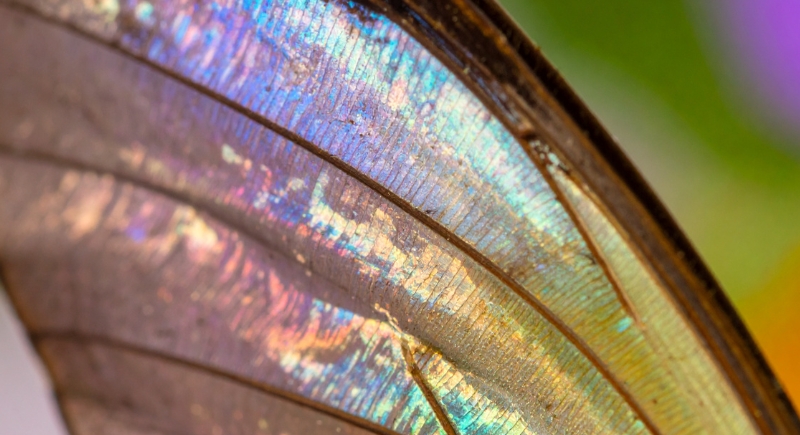The Mind-Blowing Science Behind How Butterfly Wings Get Their Color
Butterfly wings get their color in ways that almost feel impossible. Up close, each wing is made of countless tiny scales that either hold pigment or manipulate light. The oranges, reds, and browns often come from natural dyes within the scales. But the glowing blues and greens aren’t pigment at all. They’re created by microscopic ridges that bend and reflect light, changing color as you move.
In fact, if you could grind a butterfly’s wing into powder (please don’t), the brilliant structural colors would fade to dull brown. That’s because what we see isn’t always pigment; it’s light trickery happening on a microscopic scale. It’s actually one of the most fascinating physics lessons in the natural world.
The Color Is in the Structure

Image via CnvStudio’s Images/Cnv Studio
The real story of butterfly color begins with both structure and pigment. Under a microscope, a butterfly’s wing looks more like roof shingles than smooth fabric. Each wing is covered in thousands of overlapping scales, stacked in precise arrangements that bend and bounce light in complex ways.
Pigments do play a small role in some species, but for others, light itself is the artist. The blue morpho butterfly is the poster insect for this optical illusion. Its wings are covered in layers of transparent scales made of chitin, the same material found in crab shells. These scales are lined with microscopic ridges and air pockets that split and scatter light waves.
When white light hits the surface, some wavelengths cancel each other out while others reinforce, which creates what scientists call constructive interference. The result is an intense electric blue that glows like neon, yet contains no blue pigment at all.
The scale’s geometry makes the optic possible. The spacing and angles of those ridges decide which color bounces back to your eyes. Tiny variations can shift the color or make it shimmer depending on where you stand. That’s why the morpho’s color seems to ripple as it moves; its wings literally bend light differently at each tilt.
Researchers at the University of Exeter found that the morpho’s structures can reflect up to 75% of blue light across wide viewing angles. No wonder these butterflies flash like mirrors even in dense forests.
More Than Just Pretty Wings
We get hung up on the beauty of butterfly wings, but it’s really engineered for survival. Many butterflies use these optical effects for camouflage, signaling, and temperature control. Those who shimmer aren’t just looking stylish; they are manipulating light to confuse predators or attract mates.
Some species, like the owl butterfly, use pigment-based browns on the underside of their wings to blend in when resting. When startled, they flash bright iridescent colors to distract attackers. Others depend on color to communicate.
Postman butterflies, for instance, use red patterns on their wings to recognize one another and avoid crossbreeding with similar species. Meanwhile, species like the African squinting bush brown (Bicyclus anynana) can change the size of their wing spots depending on the season. In dry months, they shrink the spots to blend with dead leaves.
In wet months, they enlarge them to ward off predators. The air temperature and humidity surrounding the caterpillars determine these seasonal changes.
Nature’s Nanotech Inspiration

Image via Canva/RyanKing999
Scientists have been obsessed with replicating the butterfly’s trick. The microscopic ridges on a morpho wing have inspired everything from anti-counterfeiting tech to solar panels and paints that never fade. Engineers study these natural nanostructures to create materials that reflect specific colors without using chemical dyes.
The same principles could lead to energy-efficient displays or even clothing that changes color with movement, all by bending light. It’s hard to believe that something as fragile as a butterfly could hold the blueprint for advanced optical engineering.